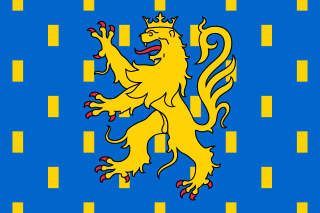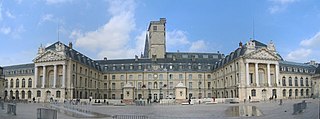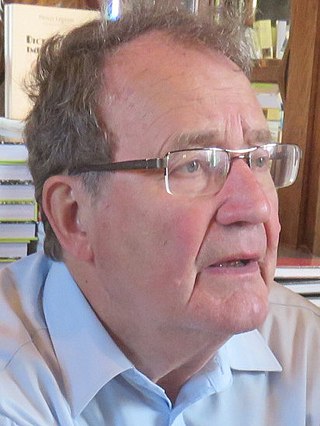
Franche-Comté is a cultural and historical region of eastern France. It is composed of the modern departments of Doubs, Jura, Haute-Saône and the Territoire de Belfort. In 2021, its population was 1,179,601.

Burgundy is a historical territory and former administrative region and province of east-central France. The province was once home to the Dukes of Burgundy from the early 11th until the late 15th century. The capital, Dijon, was wealthy and powerful, being a major European centre of art and science, and of Western Monasticism. In early Modern Europe, Burgundy was a focal point of courtly culture that set the fashion for European royal houses and their court. The Duchy of Burgundy was a key in the transformation of the Middle Ages towards early modern Europe.

Côte-d'Or is a département in the Bourgogne-Franche-Comté region of Northeastern France. In 2019, it had a population of 534,124. Its prefecture is Dijon and subprefectures are Beaune and Montbard.

Saône-et-Loire is a department in the Bourgogne-Franche-Comté region in France. It is named after the rivers Saône and Loire, between which it lies, in the country's central-eastern part.

Yonne is a département in the Bourgogne-Franche-Comté region in France. It is named after the river Yonne, which flows through it, in the country's north-central part. One of Bourgogne-Franche-Comté's eight constituent departments, it is located in its northwestern part, bordering Île-de-France. It was created in 1790 during the French Revolution. Its prefecture is Auxerre, with subprefectures in Avallon and Sens. Its INSEE and postcode number is 89.

Dijon is a city that serves as the prefecture of the Côte-d'Or department and of the Bourgogne-Franche-Comté region in eastern France. As of 2017 the commune had a population of 156,920.

The Palace of the Dukes and Estates of Burgundy or Palais des ducs et des États de Bourgogne is a remarkably well-preserved architectural assemblage in Dijon. The oldest part is the 14th and 15th century Gothic ducal palace and seat of the Dukes of Burgundy, made up of a logis still visible on Place de la Liberation, the ducal kitchens on Cour de Bar, the Tour de Philippe le Bon, a "guette" overlooking the whole city, and Tour de Bar. Most of what can be seen today, however, was built in the 17th and especially the 18th centuries, in a neoclassical style, when the palace was a royal residence building and housed the estates of Burgundy. Finally, the façade of the musée on place de la Sainte-Chapelle was added in the 19th century: it was erected on the site of the palace's Sainte-Chapelle, demolished in 1802. The Palace houses the city's Hôtel de Ville and the musée des Beaux-Arts. It was designated a monument historique by the French government in 1926.

Étienne Tabourot, seigneur des Accords, also called Tabourot des Accords or Seigneur des Accords (1549–1590) was a French jurist, writer and poet of the Renaissance.

Gare de Dijon-Porte-Neuve is a French train station located at Junot Avenue in Dijon. It is in the Côte-d'Or department, within France's Bourgogne-Franche-Comté region. Gare de Dijon-Porte-Neuve is the secondary station for the city of Dijon, with the primary station being Gare de Dijon-Ville. TER trains take six minutes to go from one station to the other, crossing the city. Gare de Dijon-Porte-Neuve is an SNCF train station, served by TER Bourgogne-Franche-Comté trains.

Bourgogne-Franche-Comté is a region in eastern France created by the 2014 territorial reform of French regions, from a merger of Burgundy and Franche-Comté. The new region came into existence on 1 January 2016, after the regional elections of December 2015, electing 100 members to the Regional Council of Bourgogne-Franche-Comté.
The following is a timeline of the history of the city of Lyon, France.
University Burgundy Franche-Comté is the association of universities and higher education institutions (ComUE) for institutions of higher education and research in the French region of Bourgogne-Franche-Comté. Its headquarters are in Besançon.
The following is a timeline of the history of the city of Orléans, France.
The following is a timeline of the history of the city of Limoges, France.

Guides Joanne was a series of French-language travel guide books to Europe founded by Adolphe Joanne and published in Paris. Routes followed the railways at first, and later volumes guided readers by province.
The following is a timeline of the history of the city of Besançon, France.
The following is a timeline of the history of the city of Caen, France.

The Regional Council of Burgundy was the deliberative assembly administering the Burgundy region until its merger in December 2015. The term can also, in a more restricted sense, designate the elected assembly which defined the policy of this community.The council was headquartered in Hôtel de Région in Dijon, at 17 boulevard de la Trémouille, next to Place de la République.

The Regional Council of Bourgogne-Franche-Comté is the deliberative assembly of the region of Bourgogne-Franche-Comté. Marie-Guite Dufay of the Socialist Party (PS) is the current president of the regional council, elected on 4 January 2016, following the regional elections on 6 and 13 December 2015.

Jean-François Bazin was a French politician, journalist, and writer.













